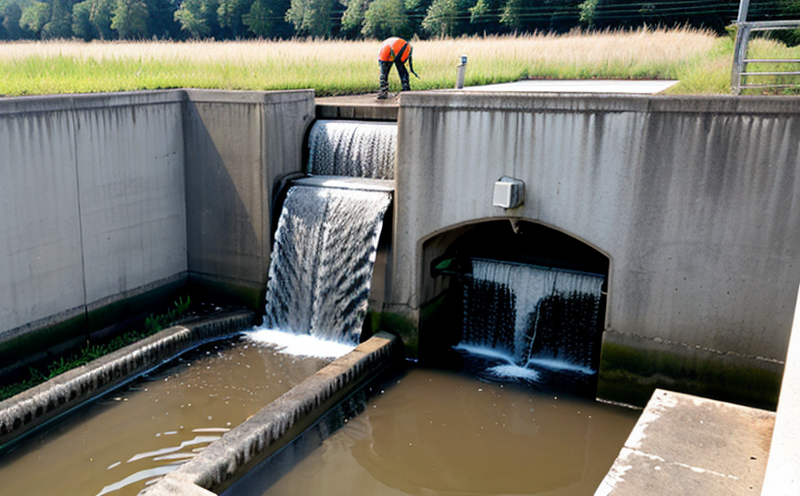Wastewater discharge monitoring inspection
The wastewater discharge monitoring inspection is a critical component in ensuring compliance with environmental regulations and maintaining the integrity of water resources. This service involves systematic evaluation of wastewater discharges to identify potential non-compliance issues, assess risks associated with environmental impacts, and provide actionable recommendations for improvement.
Our laboratory offers comprehensive testing services that cover parameters such as pH levels, total suspended solids (TSS), biochemical oxygen demand (BOD), chemical oxygen demand (COD), heavy metals, nutrients, and pathogens. We adhere to international standards like ISO 14025 and ISO 17025 to ensure the accuracy and reliability of our results.
The primary goal of wastewater discharge monitoring is to minimize environmental harm by identifying potential sources of contamination before they reach sensitive ecosystems. By conducting regular inspections, we help clients stay ahead of regulatory changes and avoid costly penalties associated with non-compliance.
Our team of experts uses advanced instrumentation and techniques to gather accurate data on various parameters. This enables us to provide detailed reports that include trends over time, comparisons against benchmarks, and actionable insights for improving wastewater treatment processes.
To ensure consistent quality across all our services, we follow strict protocols for sample collection, preservation, transport, and analysis. Our facilities are equipped with state-of-the-art equipment capable of detecting even trace amounts of contaminants.
By partnering with us, you can trust that your operations will be conducted in a manner that protects both human health and the environment. Our commitment to excellence ensures that you receive reliable data and expert advice tailored specifically for your unique needs.
Customer Impact and Satisfaction
The impact of wastewater discharge monitoring inspections extends far beyond mere compliance; it directly influences customer satisfaction by ensuring high-quality environmental stewardship. Our clients benefit from reduced risk of regulatory fines, enhanced reputation through proactive management practices, improved operational efficiency due to targeted improvements, and greater confidence in meeting sustainability goals.
- Reduces the likelihood of costly legal actions or reputational damage resulting from non-compliance.
- Promotes sustainable business practices that align with broader environmental initiatives.
- Enhances internal processes through continuous improvement strategies informed by our findings.
- Fosters long-term relationships based on trust and transparency regarding environmental performance.
We strive to exceed expectations by providing timely, accurate results alongside personalized recommendations designed specifically for each client's situation. Our approach ensures that customers not only meet current regulations but also anticipate future requirements, thereby fostering sustainable growth within their organizations.
Competitive Advantage and Market Impact
In today’s competitive market, companies must demonstrate a strong commitment to environmental responsibility to differentiate themselves from competitors. By implementing effective wastewater discharge monitoring programs, businesses can gain significant advantages over those who neglect such measures:
- Enhanced Reputation: Demonstrating leadership in environmental protection enhances brand value and attracts environmentally-conscious customers.
- Loyalty Programs: Engaging stakeholders through transparent communication fosters loyalty among employees, investors, and local communities.
- Operational Efficiency: Identifying inefficiencies early allows for corrective actions that reduce costs while improving overall performance.
- Innovation Opportunities: Continuous monitoring provides valuable data points that drive innovation in product development and process optimization.
Our laboratory plays a crucial role in helping organizations achieve these benefits by offering expert analysis supported by robust scientific evidence. This enables decision-makers to make informed choices about their environmental practices, ultimately leading to more sustainable business models.
Use Cases and Application Examples
| Application Example | Description |
|---|---|
| Industrial Wastewater Treatment Plants | Monitoring discharge from industrial plants helps identify areas where further treatment may be necessary to meet stringent regulatory standards. |
| Municipal Sewage Systems | Regular inspections of municipal sewage systems ensure proper functioning and prevent potential leaks or overflows that could contaminate nearby water bodies. |
| Hazardous Waste Facilities | Testing hazardous waste streams prior to disposal ensures compliance with strict chemical limits set by relevant authorities. |
| Agricultural Operations | Evaluating runoff from agricultural fields aids in determining best management practices for reducing nutrient loading into nearby waterways. |
These examples illustrate just a few of the ways in which wastewater discharge monitoring inspections contribute to better environmental outcomes. Whether you're an industrial facility, municipal organization, or agricultural business, our services can help you achieve your specific goals related to pollution prevention and control.
- Treatment Plant Optimization: By analyzing data from various stages of the treatment process, operators can fine-tune their processes for maximum efficiency.
- Contaminant Identification: Detecting early signs of contamination allows for swift action to mitigate any adverse effects on local ecosystems.
- Compliance Assurance: Regular assessments ensure ongoing adherence to all applicable regulations and guidelines.
- Public Health Protection: Minimizing the release of harmful substances into the environment directly contributes to public health by reducing exposure risks.
Our team works closely with clients throughout every stage of the inspection process, from initial consultation through final report delivery. This collaborative approach ensures that all needs are addressed comprehensively and efficiently.





